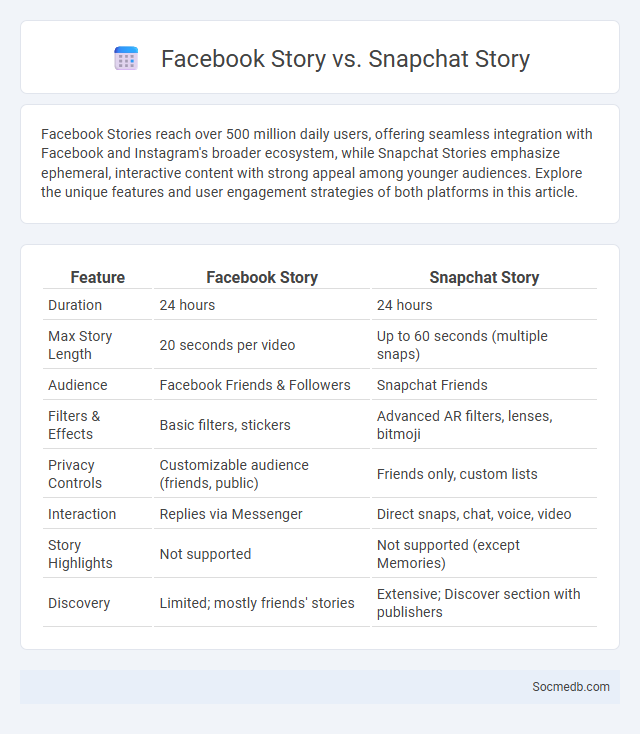
Photo illustration: Facebook Story vs Snapchat Story
Facebook Stories reach over 500 million daily users, offering seamless integration with Facebook and Instagram's broader ecosystem, while Snapchat Stories emphasize ephemeral, interactive content with strong appeal among younger audiences. Explore the unique features and user engagement strategies of both platforms in this article.
Table of Comparison
| Feature | Facebook Story | Snapchat Story |
|---|---|---|
| Duration | 24 hours | 24 hours |
| Max Story Length | 20 seconds per video | Up to 60 seconds (multiple snaps) |
| Audience | Facebook Friends & Followers | Snapchat Friends |
| Filters & Effects | Basic filters, stickers | Advanced AR filters, lenses, bitmoji |
| Privacy Controls | Customizable audience (friends, public) | Friends only, custom lists |
| Interaction | Replies via Messenger | Direct snaps, chat, voice, video |
| Story Highlights | Not supported | Not supported (except Memories) |
| Discovery | Limited; mostly friends' stories | Extensive; Discover section with publishers |
Introduction to Social Media Stories
Social media stories are short, temporary posts available on platforms like Instagram, Facebook, and Snapchat, designed to engage users through visual content such as photos and videos. These stories typically disappear after 24 hours, creating a sense of urgency and encouraging real-time interaction. Utilizing features like polls, stickers, and swipe-up links, social media stories enhance audience engagement and brand visibility.
What is a Facebook Story?
A Facebook Story is a short, ephemeral photo or video post that disappears after 24 hours, designed to share moments instantly with friends and followers. These Stories appear prominently at the top of the Facebook News Feed, enabling users to engage through reactions, comments, or shares before the content vanishes. Optimized for mobile use, Facebook Stories support interactive features like polls, stickers, and filters to boost engagement and visibility.
What is a Snapchat Story?
A Snapchat Story is a collection of snaps that you post for your friends or followers to view for 24 hours, allowing you to share moments, updates, or events in a sequential format. This feature enables real-time engagement and visibility, as Snapchat Stories appear at the top of the app's feed, enhancing your social interaction and content reach. Your Story's privacy settings can be customized, giving you control over who sees your shared content.
Exploring "Story" Features Across Platforms
Social media platforms like Instagram, Facebook, Snapchat, and TikTok utilize "Story" features to enable users to share ephemeral content that disappears after 24 hours, enhancing real-time engagement and authenticity. Instagram Stories offer interactive tools such as polls, quizzes, and stickers, while Snapchat pioneered augmented reality filters and Bitmoji integration. TikTok's Story-like features emphasize short, engaging videos with music overlays, driving viral trends and personalized content discovery.
Key Differences: Facebook Story vs Snapchat Story
Facebook Stories allow for a broader audience reach by integrating with the user's entire friend list and public followers, whereas Snapchat Stories primarily target close friends and private groups through personalized, ephemeral content. Facebook Stories offer longer viewing windows of 24 hours with options for cross-posting to Instagram Stories, while Snapchat Stories emphasize real-time sharing with disappearing snaps and unique AR filters that enhance user engagement. The analytics tools on Facebook provide detailed insights into story performance and demographics, contrasting with Snapchat's simpler, more casual approach to user interaction metrics.
User Interface and Experience Comparison
User interface (UI) and user experience (UX) are critical factors that differentiate social media platforms like Facebook, Instagram, and Twitter. Facebook offers a complex UI with extensive features, which may overwhelm new users, while Instagram focuses on a minimalist, visually-driven UI that enhances user engagement through intuitive navigation and content discovery. Your overall satisfaction depends on how seamlessly the platform's UX adapts to your preferences, ease of content sharing, and responsiveness during interactions.
Privacy and Trust: Which Story is Safer?
Social media platforms vary significantly in their approach to privacy and data protection, with some prioritizing end-to-end encryption and minimal data collection to build user trust. Stories shared on platforms like Signal or Telegram offer enhanced privacy features, reducing risks of data breaches and unauthorized access compared to mainstream networks. Users seeking safer social media stories should consider platforms with transparent privacy policies and strong security protocols to protect personal information.
Creative Tools and Effects: Who Leads the Way?
TikTok leads the way in creative tools and effects, offering a robust suite of filters, AR effects, and editing features that empower your content to stand out. Instagram follows closely with its extensive Reels tools and innovative augmented reality filters, appealing to creators seeking dynamic visual storytelling. Snapchat also remains a significant player by continually updating its lens library, ensuring interactive and immersive experiences for users worldwide.
Audience Engagement and Reach
Maximizing audience engagement on social media requires creating compelling content tailored to your target demographic's interests and behaviors. Utilizing data analytics to understand peak activity times and preferred content formats enhances your reach and interaction rates. You can boost your online presence by consistently engaging with followers through comments, shares, and personalized responses that build a loyal community.
Which Story Platform is Best for You?
Choosing the best story platform depends on your target audience and content style. Instagram Stories offer interactive features like polls and music, ideal for engaging younger users with visual content. Snapchat's ephemeral nature suits real-time updates, while Facebook Stories reach a broader demographic, making it essential to align the platform with your goals for maximum impact.
 socmedb.com
socmedb.com